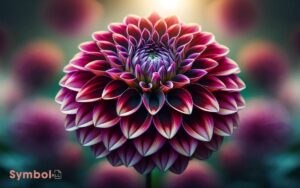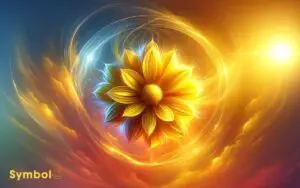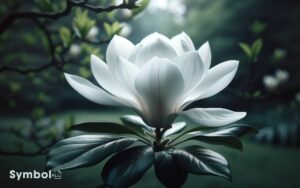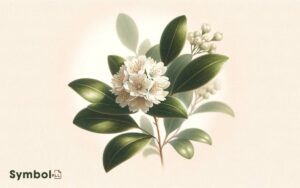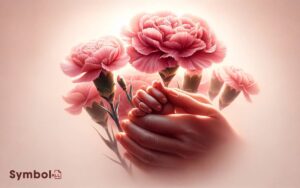Which Flower Symbolizes Pure Love and Good Luck? Pure Love!
You’re seeking a flower that epitomizes both pure love and good luck. The red rose fits this unique blend perfectly. Culturally, it’s been a symbol of deep, passionate love for centuries, transcending various cultural boundaries.
Horticulturally, its velvety petals and alluring aroma are the result of sophisticated evolutionary adaptations designed for maximum attraction and pollination efficiency. This bloom isn’t just about aesthetics; its biological and cultural layers add depth to its symbolism.
Red roses are powerful messengers of emotional depth and desire, making them unparalleled in expressing heartfelt love and wishes for prosperity. Exploring further reveals more insights into this fascinating symbol.
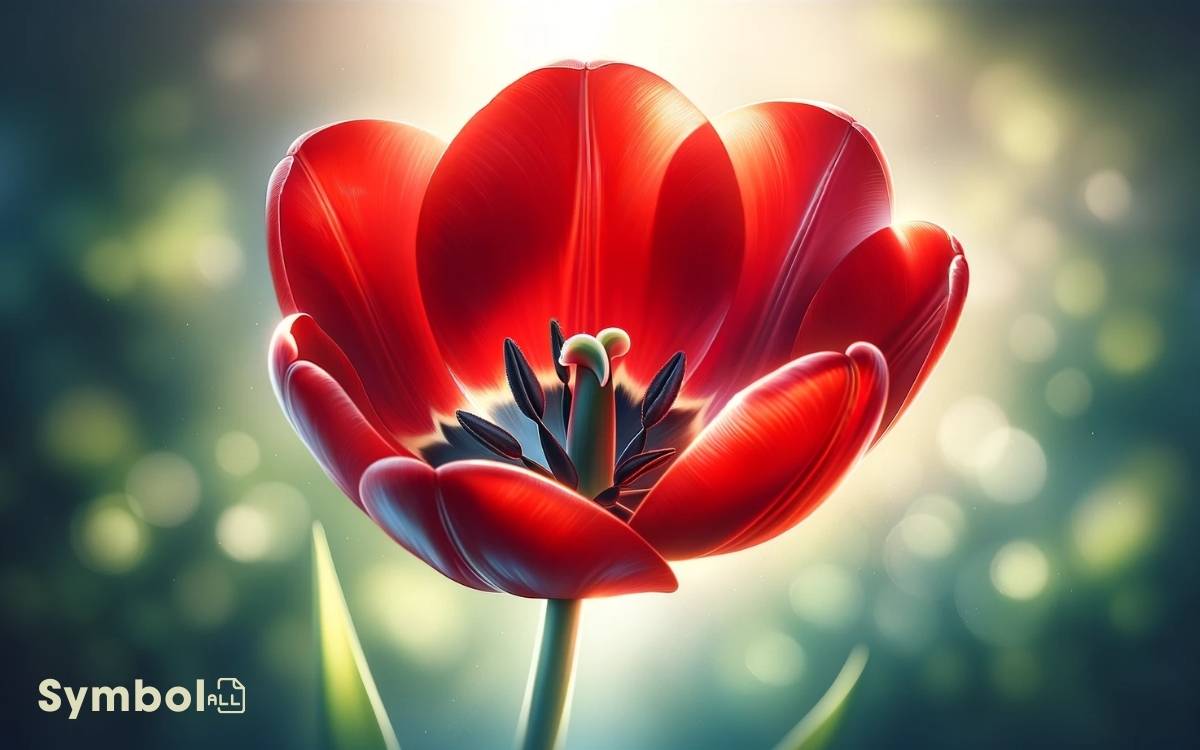
Key Takeaways
The Enigma of Flowers
Delving into the enigma of flowers, it’s crucial to comprehend their intricate biology and the elaborate ways they’ve evolved to communicate with pollinators. Each bloom has developed unique mechanisms for survival and reproduction.
For example, you’ll find that flowers produce specific scents and colors to attract bees, butterflies, and other pollinating agents.
These characteristics aren’t just happenstance; they’re the result of millions of years of evolution, fine-tuning interactions between flora and fauna to guarantee mutual benefit.
Additionally, the structure of a flower, from its petals to its reproductive organs, is designed to maximize pollination efficiency.
Understanding these biological intricacies provides a foundation for appreciating the symbolic meanings attributed to flowers, without delving into those symbolic interpretations just yet.
Unraveling Floral Symbols
Throughout history, numerous flowers have been ascribed with specific symbolic meanings, reflecting human emotions, beliefs, and desires.
To deepen your understanding, let’s explore a few key symbols:
| Flower | Symbolic Meaning | Origin |
|---|---|---|
| Rose | Love, Passion | Global |
| Lotus | Purity, Enlightenment | Eastern Cultures |
| Lily | Renewal, Purity | Various |
| Orchid | Luxury, Beauty | Global |
| Tulip | Declaration of Love | Middle East |
Each flower carries a unique narrative, tightly woven into human culture. For instance, the rose, universally recognized for love, varies in meaning with its color, while the lotus represents purity and enlightenment in Eastern philosophies.
This intricate language of flowers offers a fascinating lens through which to view our world, encouraging a deeper appreciation for the natural symbols that surround us.
The Quest for Pure Love
Embarking on the journey for pure love, it’s crucial to comprehend the historical and cultural significances intertwined with the symbolism of flowers, which serve as metaphors for deep, abiding affection and connection.
Within this search, you’ll discover that specific flowers have been designated to represent pure love across various cultures and epochs.
For instance, the red rose, universally recognized for its association with romantic love, owes its status to ancient mythology and centuries of literary references that emphasize its connection to deep, passionate love.
Analyzing the botanical characteristics and growth conditions of these flowers reveals additional layers of meaning.
The resilience of a rose, blooming despite thorns, mirrors the enduring nature of true love, offering a nuanced understanding of how flora symbolize the complexity and depth of human emotions.
Fortunes in Petals
Beyond the domain of pure love symbolized by flowers, it’s equally fascinating to explore how certain blooms are believed to herald good luck, embodying prosperity and well-being through their unique characteristics and historical associations.
For instance, the four-leaf clover, though not a flower, is universally recognized for bringing good fortune. However, in the floral world, the Peony stands out, with its lush, full blossoms associated with wealth and honor, especially in Eastern cultures.
Similarly, the Chrysanthemum, particularly in gold hues, is celebrated for attracting good luck in the home.
Additionally, the White Jasmine, with its intoxicating fragrance, is heralded for promoting positive energy and strengthening relationships, thereby contributing to a person’s overall happiness and good fortune.
These flowers, with their specific attributes, serve as powerful symbols of luck and prosperity.
A Historical Perspective
You’ll find that flowers have played pivotal roles in ancient rituals and beliefs, underscoring their deep-rooted cultural significance across the globe.
This historical backdrop paves the way for understanding how the symbolism of flowers, particularly those representing pure love and good luck, has evolved over centuries.
Such an exploration reveals intricate layers of meaning that have been attributed to these botanical wonders, reflecting shifts in societal values and perceptions.
Ancient Rituals and Beliefs
Throughout history, civilizations have embraced various flowers as symbols of pure love and good fortune, integrating them into rituals and beliefs with profound cultural significance.
These practices often involved intricate ceremonies where specific flowers played central roles, reflecting the community’s values and aspirations.
For instance, the ancient Egyptians utilized lotus flowers in burial rites, symbolizing resurrection and eternal love. Similarly, in Greek mythology, roses were associated with Aphrodite, the goddess of love, denoting deep affection and adoration.
These rituals weren’t merely symbolic but served as conduits for transmitting cultural norms and values across generations.
They underscored the belief in the transformative power of flowers to convey sentiments, ward off evil, and attract positive outcomes, embedding these plants deeply into the cultural fabric.
Cultural Significance Worldwide
Building on the foundation of ancient rituals and beliefs, let’s explore the global cultural significance of flowers, examining their historical roles across different societies.
Throughout history, flowers have held a myriad of meanings and functions. In ancient Egypt, for instance, lotus flowers were symbols of rebirth and the sun, deeply intertwined with the mythology and daily life of the civilization.
Moving to East Asia, the cherry blossom in Japan, known as sakura, epitomizes the transient nature of life, a concept deeply rooted in Buddhist philosophy.
In Western cultures, the rose has evolved as a symbol of love and beauty, with its cultivation dating back to Roman times when these flowers adorned public baths.
Each of these examples underscores flowers’ profound impact on cultural practices, religious ceremonies, and social rituals worldwide.
Evolution of Floral Symbolism
The evolution of floral symbolism, tracing back to ancient civilizations, has profoundly impacted humanity’s cultural and social fabrics. You’ll find its traces in every nook of history, shaping traditions, art, and even politics.
Let’s explore a detailed overview:
| Era | Civilization | Symbolic Use |
|---|---|---|
| 2000 BC | Ancient Egypt | Flowers in religious ceremonies |
| 500 BC | Ancient Greece | Laurel wreaths symbolizing victory |
| 1400 AD | Medieval Europe | Flowers in heraldry |
| 1600 AD | Renaissance | Floral still-life paintings as allegory |
| 1800 AD | Victorian England | The language of flowers (Floriography) |
This table highlights pivotal moments where floral symbolism evolved, embedding deeper meanings into societal values. Each era utilized flowers uniquely, enriching cultural narratives and communicating emotions and ideas that words alone couldn’t capture.
Cultural Significance Unveiled
You’ll uncover the layers of symbolic meanings these flowers hold, spanning various cultures and traditions.
By examining the traditions across cultures, you grasp the universal and unique significance attributed to them.
This exploration sheds light on how these symbols of pure love and good luck are woven into the fabric of cultural identities worldwide.
Symbolic Meanings Explored
Delving into the symbolic meanings of flowers reveals a rich tapestry of cultural significance, where each bloom carries a unique message of pure love and good luck across various traditions.
Understanding these symbols can enhance your appreciation of floral gifts and decorations, providing deeper insight into their intended messages.
- Roses: Universally recognized for symbolizing love, different colors convey specific sentiments red for romantic love, white for purity, and yellow for friendship.
- Peonies: Often associated with good luck, prosperity, and bashful love. In many cultures, they’re given to express wishes for a happy marriage.
- Lotus Flowers: Symbolize purity, enlightenment, self-regeneration, and rebirth across various Eastern traditions. Their ability to bloom in murky waters is seen as a proof of the perseverance of love through challenging circumstances.
Traditions Across Cultures
Exploring the cultural significance of flowers reveals traditions across cultures imbuing these natural beauties with varied, profound meanings tied to love and fortune.
- In Japan, the cherry blossom, or sakura, symbolizes the ephemeral nature of life and purity, fostering celebrations of beauty and renewal.
- Conversely, the ancient Greeks adorned brides and banquets with ivy, symbolizing eternal love and fidelity, a demonstration of its enduring presence.
- Meanwhile, in Chinese culture, peonies are esteemed as tokens of good luck and prosperity, often featured in art and festivals to invoke wealth and honor.
Each flower carries a unique narrative, meticulously woven into the fabric of cultural rituals and beliefs, providing a nuanced understanding of its significance in expressing emotions and commemorating life’s milestones.
The Ultimate Love Charm
In the domain of floral symbolism, the red rose stands as the ultimate charm for expressing deep love and securing good fortune in romantic endeavors. Cultivated for over 5,000 years, its history is as rich as its hues.
The red rose’s vibrant color and delicate petals symbolize the heart’s depth and the complexities of love. Its enduring presence in romantic gestures across various cultures underlines its universal appeal and effectiveness as a love charm.
- Cultural Significance: Revered in many societies for its symbolism of love and passion.
- Botanical Features: Unique characteristics, such as velvety petals and a seductive fragrance, enhance its appeal.
- Gifting Practices: A single stem or a bouquet conveys profound emotions, making it an ideal choice for romantic occasions.
Good Luck Blossoms
As you venture into the domain of Good Luck Blossoms, you’ll discover that certain flowers, known as Lucky Charm Flowers, carry symbols of fortune and prosperity.
These blossoms, including Prosperity Through Petals, harness unique attributes that enhance positive energy and financial success.
Specifically, Blooms of Good Fortune are revered for their ability to attract luck, making them essential components in rituals and spaces aimed at boosting favorable outcomes.
Lucky Charm Flowers
Certain flowers are believed to bring good luck and fortune, serving as powerful symbols in various cultural traditions. These plants aren’t just decorative; they’re imbued with significant meanings and properties that can influence your well-being and prosperity.
By incorporating these lucky charm flowers into your life, you’re tapping into centuries-old wisdom and enhancing your surroundings with positivity and potential for good fortune.
- Jade Plant (Crassula ovata): Known for its succulent green leaves, the Jade Plant is a symbol of financial growth and prosperity.
- Four-Leaf Clover (Trifolium repens): Rare and highly sought-after, this variation of the common three-leaf clover is a universal sign of good luck.
- Peony (Paeonia): Celebrated in many cultures for its lush, full blooms, the peony represents wealth, good fortune, and honor.
Prosperity Through Petals
Delving into the domain of ‘Prosperity Through Petals’ reveals that certain flowers possess the ability to draw in good luck and fortune into your life.
Understanding the specificity behind each flower’s ability to attract prosperity can greatly enhance your selection process, ensuring you choose blooms that align with your desires for good fortune.
Here’s a concise table to guide you:
| Flower | Significance |
|---|---|
| Peony | Wealth, honor, and high status |
| Jade Vine | Strong relationships and luck |
| Orchid | Fertility and abundance |
| Chrysanthemum | Longevity and rejuvenation |
| Narcissus | Renewal and new beginnings |
Each of these flowers carries a unique vibration that aligns with specific aspects of prosperity, making them powerful allies in your quest for good fortune. Choose wisely to harness their full potential.
Blooms of Good Fortune
Discovering the domain of ‘Blooms of Good Fortune’ reveals a variety of flowers celebrated for their power to draw luck and positivity into your life.
Delving deeper into this fascinating subject, you’ll uncover the intricate ways these blossoms influence well-being and fortune. Through meticulous cultivation and understanding of their properties, you can harness their full potential.
- Jade Plant Flowers: Symbolizing financial growth, these blooms thrive in well-drained soil, requiring minimal water, making them an emblem of prosperity and resilience.
- Peonies: Known for attracting good luck and romance, their cultivation demands well-aerated soil and ample sunlight, embodying richness and honor.
- Four-Leaf Clovers: Though not a flower, their rarity and association with good fortune make them a sought-after charm, thriving in nitrogen-rich soil.
The Flower of Dual Meanings
In the domain of floral symbolism, the lotus flower stands out for its unique dual meanings of pure love and good fortune.
This emblematic bloom, deeply rooted in muddy waters, unfolds its petals in a pristine and graceful manner, symbolizing an untainted heart and the emergence of beauty amidst adversity. The lotus’s resilience is a metaphor for enduring love that triumphs over challenges.
Additionally, in various cultures, the lotus represents luck, with its ability to emerge so flawlessly from murky environments seen as a sign of divine favor.
Its biological characteristics, such as the self-cleaning ability known as the ‘lotus effect,’ further accentuate its symbolism of purity and rebirth.
Understanding the lotus’s profound meanings enriches one’s appreciation for its significance in expressing deep, unconditional love and the aspiration for a fortunate life.
Contemporary Celebrations
Today, the lotus flower plays a central role in modern celebrations, symbolizing themes of rebirth and new beginnings across various cultural events and personal milestones.
Its unique lifecycle, emerging pure and beautiful from murky waters, offers a powerful metaphor for transformation and growth.
This symbolism is deeply woven into contemporary celebrations, where the lotus serves not only as a decorative element but also as a meaningful emblem of significant life changes.
To help you appreciate the lotus flower’s significance in modern festivities, consider the following:
- Weddings: Symbolizing union and harmony, lotus flowers often adorn wedding venues, representing pure love between partners.
- New Year Celebrations: In many cultures, the lotus symbolizes good fortune and renewal, making it a popular decor choice.
- Spiritual Gatherings: Reflecting spiritual awakening, the lotus is central in events promoting personal growth and enlightenment.
Gardening With Symbolism
Building on its cultural significance, integrating lotus flowers into your garden can create a space rich with symbolism, embodying themes of purity, love, and fortune.
To cultivate these aquatic plants effectively, you’ll need a water feature or pond, as lotuses thrive in still or slow-moving water. Opt for a sunny spot, as lotuses require at least six hours of sunlight daily to bloom successfully.
Plant lotus tubers in heavy clay soil within a shallow, wide container that allows ample room for growth. Submerge the container carefully, guaranteeing the top is just below the water surface to prevent rot.
Regular maintenance, including trimming dead foliage and managing water levels, will guarantee your lotus flowers flourish, weaving a tapestry of meaningful beauty into your garden landscape.
Crafting Romantic Bouquets
To craft a romantic bouquet that encapsulates pure love and good luck, you’ll need to select flowers with both aesthetic appeal and rich symbolic meanings. This process requires a deep understanding of floriculture and the historical significance of each bloom.
- Consider Color: Choose flowers with colors that symbolize love, such as reds and pinks, and mix them with whites or greens to represent good luck.
- Focus on Freshness: Guarantee all chosen flowers are fresh; this not only enhances the bouquet’s visual appeal but also its longevity.
- Balance Proportions: Pay attention to the size and shape of each flower. A well-balanced bouquet combines various textures and heights for a visually pleasing arrangement.
Embracing Floral Traditions
Exploring floral traditions enriches your understanding of how different cultures have used flowers to symbolize pure love and good luck throughout history.
You’ll find that the significance of flowers transcends mere aesthetics, delving into deep-rooted cultural beliefs and practices. These traditions offer a lens through which we can appreciate the nuanced language of flowers.
| Culture | Flower | Significance |
|---|---|---|
| Japanese | Cherry Blossom | Transience of life, renewal, and optimism |
| Chinese | Peony | Prosperity, happiness, and peace |
| Egyptian | Lotus | Purity, rebirth, and the sun |
Each flower’s significance is deeply ingrained in its respective culture’s traditions and beliefs, serving as a symbol of more than just beauty.
They carry messages of love, luck, and good fortune, making them powerful tools in expressing complex human emotions and desires.
Conclusion
So, you’ve journeyed through the enchanting world of flowers, unraveling symbols of pure love and good fortune.
Why not bring these traditions into your own garden or next romantic gesture? Crafting bouquets with the likes of roses for love and peonies for luck isn’t just a nod to tradition—it’s a science of sentiment, blending aesthetics with meaning.
Embrace the art of floral symbolism, and let each petal reflect your deepest affections and aspirations for good fortune.

